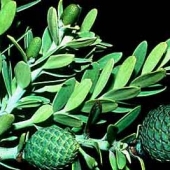Please select root levels for the menu
NZ Plants
Podocarpus nivalis - snow tōtara
Podocarp family: Podocarpaceae
-
Plant
L Jensen
View picture -
Branch
L Jensen
View picture -
Pollen cones
Bill Malcolm
View picture -
Mature seed cone
J Braggins
View picture
Podocarpus nivalis varies from a prostrate shrub with wide-spreading branches to a small bush. Foliage is a dark to bronze-green and consists of closely spaced leathery linear leaves. Small, fleshy ovule cones are formed in which a green epimatium (an outgrowth of the seed scale) covers the developing seed. After fertilisation the bases of the fertile and sterile scales fuse and become fleshy to form a red receptacle.
An endemic species found at higher elevations on the North Island to lowland forest on the South Island.
A genus of over 100 species, with two endemic to New Zealand. Other species are found in Africa, Madagascar, Australia, Fiji,Tonga, South and Central America, the Caribbean, southeast Asia, China, Japan and New Guinea.
Vegetative characteristics |
Reproductive characteristics |
|---|---|
Adult plant form: prostrate shrub up to 3 m |
Pollen and ovule cones: on separate plants |
Adult leaf form: linear, rigid |
Pollen cone: 5-15 mm long |
Adult leaf size: 5-15 x 2-4 mm |
Ovule cone: 5-8 mm long, 1-2 fertile bracts |
Adult leaf arrangement: spiral, close set |
Ovule position: on upper surface of a fertile bract subtended by fused sterile bracts (receptacle) |
Juvenile leaf form: no distinct juvenile form |
Ovule coverings: an inner covering (integument); an outer covering (epimatium) covers the entire ovule; |
Juvenile leaf size: |
Ovule pore (micropyle): directed downward |
Juvenile leaf arrangement: |
Mature seed cone: fleshy, 10-15 long, 1-2 seeds |
Stem(receptacle) below seed: fleshy, derived from basal bracts of the receptacle; red |




